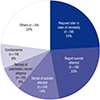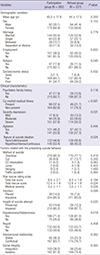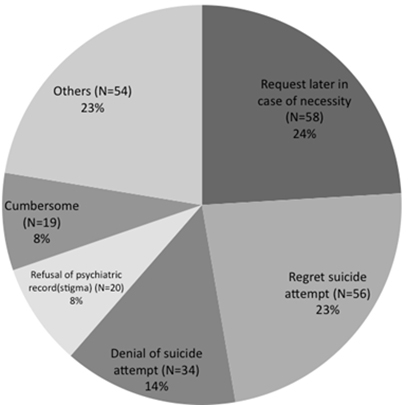1. Rudd MD, Goulding JM, Carlisle CJ. Stigma and suicide warning signs. Arch Suicide Res. 2013; 17:313–318.
2. Lee HS, Kim S, Choi I, Lee KU. Prevalence and risk factors associated with suicide ideation and attempts in korean college students. Psychiatry Investig. 2008; 5:86–93.
3. Chastang F, Rioux P, Dupont I, Baranger E, Kovess V, Zarifian E. Risk factors associated with suicide attempt in young French people. Acta Psychiatr Scand. 1998; 98:474–479.
4. Meszaros K, Fischer-Danzinger D. Extended suicide attempt: psychopathology, personality and risk factors. Psychopathology. 2000; 33:5–10.
5. Choi KH, Wang SM, Yeon B, Suh SY, Oh Y, Lee HK, Kweon YS, Lee CT, Lee KU. Risk and protective factors predicting multiple suicide attempts. Psychiatry Res. 2013; 210:957–961.
6. Kweon YS, Hwang S, Yeon B, Choi KH, Oh Y, Lee HK, Lee CT, Lee KU. Characteristics of drug overdose in young suicide attempters. Clin Psychopharmacol Neurosci. 2012; 10:180–184.
7. Kim YR, Choi KH, Oh Y, Lee HK, Kweon YS, Lee CT, Lee KU. Elderly suicide attempters by self-poisoning in Korea. Int Psychogeriatr. 2011; 23:979–985.
8. Roberts RE, Roberts CR, Chen YR. Suicidal thinking among adolescents with a history of attempted suicide. J Am Acad Child Adolesc Psychiatry. 1998; 37:1294–1300.
9. Suominen K, Isometsä E, Suokas J, Haukka J, Achte K, Lönnqvist J. Completed suicide after a suicide attempt: a 37-year follow-up study. Am J Psychiatry. 2004; 161:562–563.
10. Maniam T, Chinna K, Lim CH, Kadir AB, Nurashikin I, Salina AA, Mariapun J. Suicide prevention program for at-risk groups: pointers from an epidemiological study. Prev Med. 2013; 57:S45–S46.
11. Donald M, Dower J, Bush R. Evaluation of a suicide prevention training program for mental health services staff. Community Ment Health J. 2013; 49:86–94.
12. Haring C, Sonneck G. Suicide Prevention Austria (SUPRA) : the implementation of a national suicide prevention program. Neuropsychiatr. 2012; 26:91–94.
13. Shim RS, Compton MT. Pilot testing and preliminary evaluation of a suicide prevention education program for emergency department personnel. Community Ment Health J. 2010; 46:585–590.
14. Szanto K, Kalmar S, Hendin H, Rihmer Z, Mann JJ. A suicide prevention program in a region with a very high suicide rate. Arch Gen Psychiatry. 2007; 64:914–920.
15. Vaiva G, Vaiva G, Ducrocq F, Meyer P, Mathieu D, Philippe A, Libersa C, Goudemand M. Effect of telephone contact on further suicide attempts in patients discharged from an emergency department: randomised controlled study. BMJ. 2006; 332:1241–1245.
16. Cebrià AI, Parra I, Pàmias M, Escayola A, García-Parés G, Puntí J, Laredo A, Vallès V, Cavero M, Oliva JC, et al. Effectiveness of a telephone management programme for patients discharged from an emergency department after a suicide attempt: controlled study in a Spanish population. J Affect Disord. 2013; 147:269–276.
17. Linehan MM, Comtois KA, Brown MZ, Heard HL, Wagner A. Suicide Attempt Self-Injury Interview (SASII): development, reliability, and validity of a scale to assess suicide attempts and intentional self-injury. Psychol Assess. 2006; 18:303–312.
18. Weisman AD, Worden JW. Risk-rescue rating in suicide assessment. Arch Gen Psychiatry. 1972; 26:553–560.
19. Jin J, Sklar GE, Min Sen Oh V, Chuen Li S. Factors affecting therapeutic compliance: A review from the patient's perspective. Ther Clin Risk Manag. 2008; 4:269–286.
20. Eisen JL, Rasmussen SA, Phillips KA, Price LH, Davidson J, Lydiard RB, Ninan P, Piggott T. Insight and treatment outcome in obsessive-compulsive disorder. Compr Psychiatry. 2001; 42:494–497.
21. Marková IS, Berrios GE. Insight in clinical psychiatry revisited. Compr Psychiatry. 1995; 36:367–376.
22. Lysaker P, Bell M, Milstein R, Bryson G, Beam-Goulet J. Insight and psychosocial treatment compliance in schizophrenia. Psychiatry. 1994; 57:307–315.
23. Lincoln TM, Lüllmann E, Rief W. Correlates and long-term consequences of poor insight in patients with schizophrenia. A systematic review. Schizophr Bull. 2007; 33:1324–1342.
24. Compton MT, Thompson NJ, Kaslow NJ. Social environment factors associated with suicide attempt among low-income African Americans: the protective role of family relationships and social support. Soc Psychiatry Psychiatr Epidemiol. 2005; 40:175–185.
25. Fairweather AK, Anstey KJ, Rodgers B, Butterworth P. Factors distinguishing suicide attempters from suicide ideators in a community sample: social issues and physical health problems. Psychol Med. 2006; 36:1235–1245.
26. De Leo D, Carollo G, Dello Buono M. Lower suicide rates associated with a Tele-Help/Tele-Check service for the elderly at home. Am J Psychiatry. 1995; 152:632–634.






 PDF
PDF ePub
ePub Citation
Citation Print
Print




 XML Download
XML Download